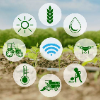In the next few years, smart farming will reach each and every nook of the world. The prospects of using unmanned aerial vehicles (UAV) for smart farming are immense. However, the cost and the ease in controlling UAVs for smart farming might play an important role for motivating farmers to use UAVs in farming. Mostly, UAVs are controlled by remote controllers using radio waves. There are several technologies such as WiFi or ZigBee that are also used for controlling UAVs. However, Smart Bluetooth (also referred to as Bluetooth Low Energy) is a wireless technology used to transfer data over short distances. Bluetooth smart is cheaper than other technologies and has the advantage of being available on every smart phone. Farmers can use any smart phone to operate their respective UAVs along with Bluetooth Smart enabled agricultural sensors in the future. However, certain requirements and challenges need to be addressed before UAVs can be operated for smart agriculture-related applications. Hence, in this article, an attempt has been made to explore the types of sensors suitable for smart farming, potential requirements and challenges for operating UAVs in smart agriculture. We have also identified the future applications of using UAVs in smart farming.
翻译:在未来几年里,智能农作将遍及世界每一个角落。使用无人驾驶航空器(无人机)进行智能农作的前景是巨大的。然而,为智能农作而控制无人驾驶航空器的成本和容易程度可能会对鼓励农民在农业中使用无人驾驶航空器起到重要作用。多数情况下,无人驾驶航空器由遥控器使用无线电波控制。还有一些技术,如WiFi或Zig Beee,也用于控制无人驾驶航空器。然而,智能蓝牙(也称为蓝牙低能)是一种用于短距离传输数据的无线技术。蓝牙比其他技术便宜,并且具有在每种智能手机上提供的好处。农民可以使用任何智能电话操作各自的无人驾驶航空器,以及今后使用蓝牙智能智能农作的农业传感器。但是,在无人驾驶飞行器用于智能农业相关应用之前,需要解决某些要求和挑战。因此,在本篇文章中,试图探索适合智能农作、潜在要求和智能农作的无人机操作挑战的传感器类型。我们还查明了未来在智能农作中应用无人机。




